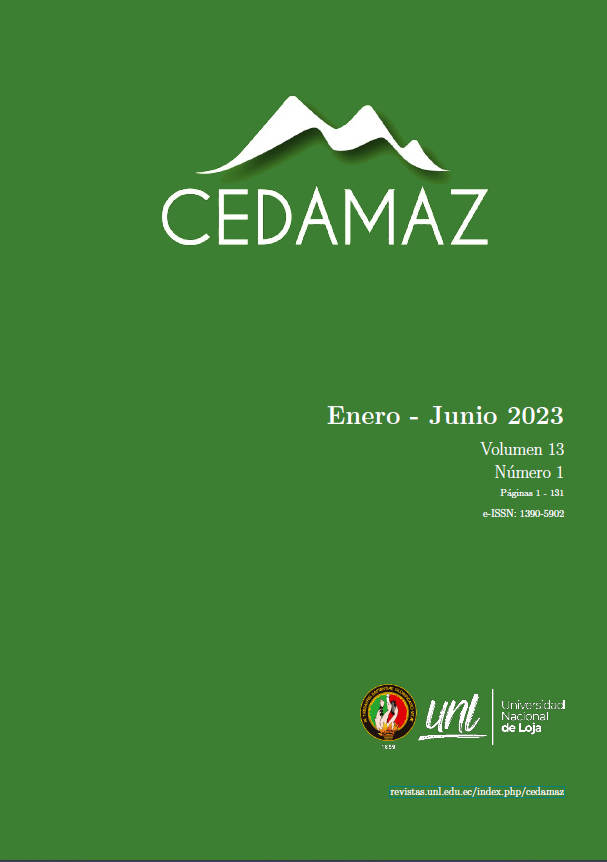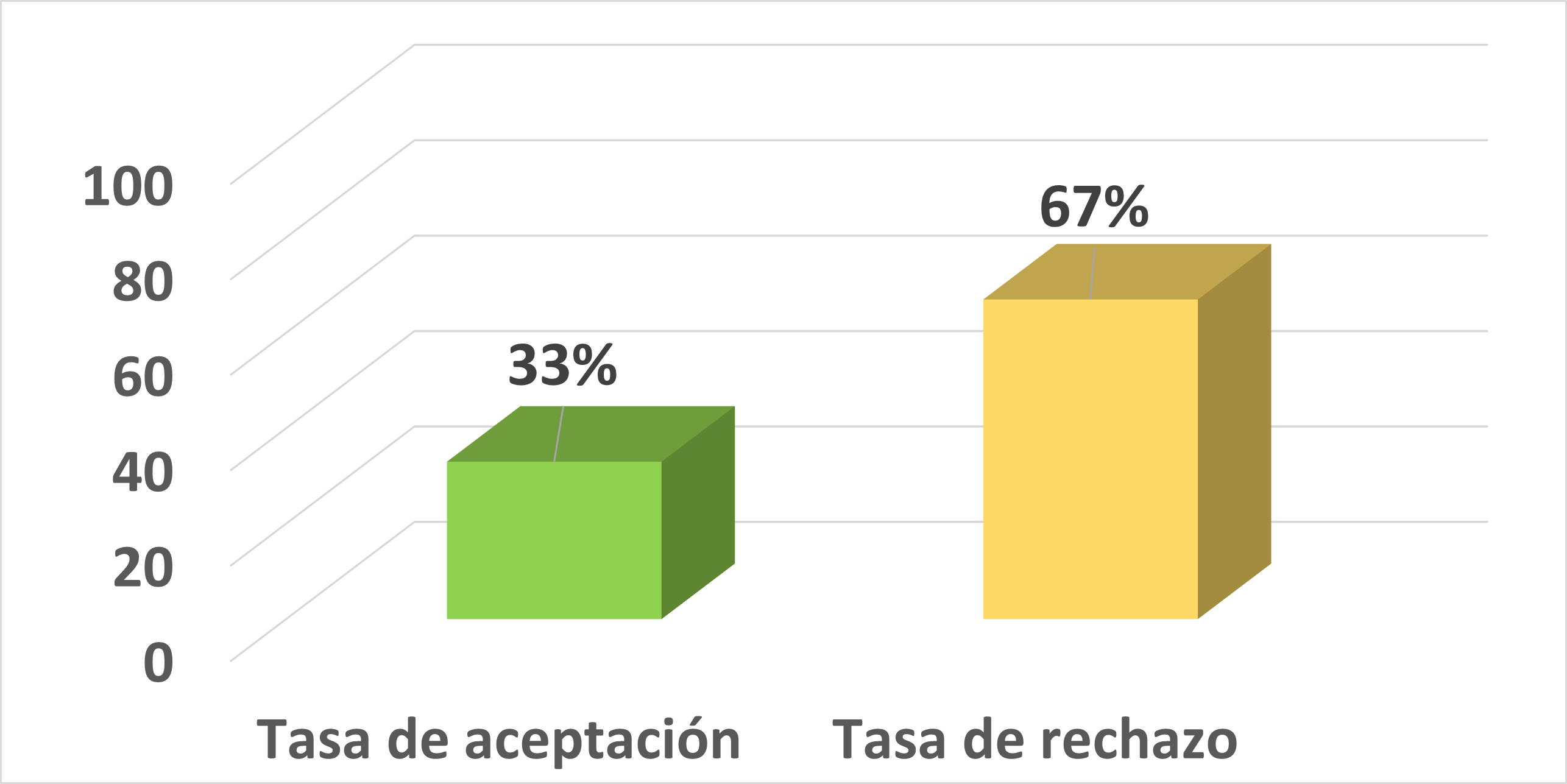Epidemiological study of leptospirosis in guinea pigs in the southern interandean region of Ecuador
DOI:
https://doi.org/10.54753/cedamaz.v13i1.1711Keywords:
Leptospira spp., Cavia porcellus, ZoonosesAbstract
Leptospirosis is one of the most important zoonoses worldwide, considered a neglected emerging disease. In Ecuador, guinea pigs are very important in feeding the population, especially in rural sectors of the inter-Andean region, however there are no investigations that allow us to know the epidemiology of leptospirosis in this species. The aim of this study was to determine the frequency of infection by Leptospira spp. and the associated factors in guinea pigs from the Chantaco and Chuquiribamba parishes of the Loja canton. 175 animals were studied using the microagglutination serological test (MAT) and conventional PCR (hap1 gene) from urine samples. An epidemiological survey was carried out to obtain information on geographic location, rearing system, type of facilities, presence of abortions in the farms, type of food, water supply, presence of other animals around the farms and rodent control; individual data of the animals such as sex and age were recorded. An infection frequency of 6.86% (12/175) was estimated. In serology, the samples were positive for the Pomona, Hardjo, Tarassovi, Sejroe, Bataviae and Canicola serovars. The associated factors (p<0.05) were the geographic location of the property and the presence of cats. This is the first report of leptospirosis in guinea pigs raised for food in Ecuador, with which it is expected that strategies and lines of action will be programmed to control the disease in the species or others that could be affected, including humans.References
Benavides, B. y Cisneros, H. y Peláez, R. (2021). Evidencia molecular de Leptospira interrogans sensu stricto en Cavia porcellus (cuyes) destinados para el consumo humano en el municipio de Pasto, Nariño. Universidad y Salud, 24(1), 55-64. https://doi.org/https://doi.org/10.22267/rus.222401.258
Boey, K. y Shiokawa, K. y Rajeev, S. (2019). Leptospira infection in rats: A literature review of global prevalence and distribution. En PLoS Neglected Tropical Diseases (Vol. 13, Issue 8). Public Library of Science. https://doi.org/10.1371/journal.pntd.0007499
Branger, C., Blanchard, B., Fillonneau, C., Suard, I., Aviat, F., Chevallier, B., & André-Fontaine, G. (2005). Polymerase chain reaction assay specific for pathogenic Leptospira based on the gene hap1 encoding the hemolysis-associated protein-1. FEMS Microbiology Letters, 243(2), 437–445. https://doi.org/10.1016/j.femsle.2005.01.007
Casanovas, A. y Pedra, G. y Wunder, E. y Diggle, P. y Begon, M. y Ko, A. (2018). Quantification of Leptospira interrogans Survival in Soil and Water Microcosms. Applied and Environmental Microbiology. https://doi.org/https://doi.org/10.1128/AEM.00507-18
Chavez-Tapia, I., & Avilés-Esquivel, D. (2022). Caracterización del sistema de producción de cuyes del cantón Mocha, Ecuador. Revista de Investigaciones Veterinarias del Perú. http://www.scielo.org.pe/scielo.php?pid=S1609-91172022000200005&script=sci_arttext
Estupiñán, P. y Burgos, A. y Chacha, S. y Baquero, M. y Gómez, C. y Sánchez, X. y Soque, A. (2018). Linfadenitis en un plantel productor de cuyes. Ecuador Es Calidad: Revista Científica Ecuatoriana, 5(1). https://doi.org/https://doi.org/10.36331/revista.v5i1.33
Ge, Y. y Sun, A. y Ojcius, D. y Li, S. y Hu, W. y Lin, X. y Yan, J. (2020). M16-Type metallopeptidases are involved in virulence for invasiveness and diffusion of Leptospira interrogans and transmission of leptospirosis. Journal of Infectious Diseases, 222(6), 1008-1020. https://doi.org/10.1093/infdis/jiaa176
Gutiérrez, A. y Morales, S. (2020). Determinación de anticuerpos contra serovares de Leptospira spp en cuyes de crianza familiar-comercial en Cajabamba, Perú. Revista de Investigaciones Veterinarias Del Perú, 31(4), e19043. https://doi.org/http://dx.doi.org/10.15381/rivep.v31i4.19043
Koizumi, N. y Morita, M. y Pheng, V. y Wann, C. y Masuoka, H. y Higa, Y. y Wada, T. y Hirayama, K. y Ohnishi, M. y Miura, K. (2022). Rat trade and leptospirosis: Molecular epidemiology of Leptospira species in rats exported from Cambodia to Vietnam. Transboundary and Emerging Diseases, 69(3), 1641-1648. https://doi.org/10.1111/tbed.14077
Lopardo, H. y Garrahan, J. y Predari, S. y Vay, C. (2021). Manual de microbiología clínica de la asociación Argentina de Microbiología. Facultad de Ciencias Exactas Universidad Nacional de La Plata, Acta Bioquímica Clínica Latinoamericana.: Vol. I.
López, G. y Cordova, F. y Sandoval, E. y Montalvo, M. (2021). Leptospirosis at human-animal-environment interfaces in Latin-America: drivers, prevention, and control measures. Revista de Ciencias Biológicas y de La Salud. http://biotecnia.unison.mx
Luna, S. (2019). “Determinación serológica de títulos de anticuerpos contra Leptospira interrogans en cuyes (Cavia porcellus) con historial de abortos en crianza intensiva del distrito de Concepción, Junín” [Universidad Cientpifica del Sur]. En Universidad Científica. https://repositorio.cientifica.edu.pe/handle/20.500.12805/1749%0Ahttps://repositorio.cientifica.edu.pe/handle/UCS/1259.
Martín, P. L., Arauz, M. S., & Stanchi, N. O. (2015). Diagnóstico de leptospirosis mediante técnicas moleculares: ventajas y limitaciones en Medicina Veterinaria. Analecta Veterinaria, 35.
Matamala, A. (2018). Evaluación de la prueba MAT y PCR en sangre y orina para determinar el estatus de infección de vacas lecheras abortadas dentro de los siete días post aborto (Universidad Austral de Chile). http://cybertesis.uach.cl/tesis/uach/2018/fvm971e/doc/fvm971e.pdf.
Mohd Ali, M. R., Mohd Safee, A. W., Ismail, N. H., Abu Sapian, R., Mat Hussin, H., Ismail, N., & Yean Yean, C. (2018). Development and validation of pan-Leptospira Taqman qPCR for the detection of Leptospira spp. in clinical specimens. Molecular and Cellular Probes, 38, 1–6. https://doi.org/10.1016/J.MCP.2018.03.001
Murillo Picco, D. A. (2020). Epidemiological and clinicopathological study of Leptospira spp. infection in cats in Spain (Catalonia and Extremadura).
Nair, N. y Gomes, M. (2020). A Mouse Model of Sublethal Leptospirosis: Protocols for Infection with Leptospira Through Natural Transmission Routes, for Monitoring Clinical and Molecular Scores of Disease,and for Evaluation of the Host Immune Response. Current Protocols in Microbiology, 59(1). https://doi.org/10.1002/cpmc.127
OIE. (2021). Capítulo 3.01.12. Leptospirosis. En Manual Terrestre de la IOE. https://www.woah.org/fileadmin/Home/esp/Health_standards/tahm/3.01.12_Leptospirosis.pdf
Ospina-Pinto, C., Rincón-Pardo, M., Soler-Tovar, D., & Hernández-Rodríguez, P. (2017). Papel de los roedores en la transmisión de Leptospira spp. en granjas porcinas. https://www.scielosp.org/article/rsap/2017.v19n4/555-561/
Putz, E. y Nally, J. (2020). Investigating the Immunological and Biological Equilibrium of Reservoir Hosts and Pathogenic Leptospira: Balancing the Solution to an Acute Problem? Frontiers in Microbiology, 11. https://doi.org/10.3389/fmicb.2020.02005
Ramirez, E. y Rodas, T. y López, C. y Romero, L. y Aguilar, V. (2017). Identificación de serovares de Leptospira spp. presentes en ratas y ratones sinantrópicos de tres cantones del municipio de Tecoluca, San Vicente, El Salvador. Revista Agrociencia.
Stoddard, R. A. (2013). Detection of pathogenic leptospira spp. through real-time PCR (qPCR) targeting the lipL32 gene. Methods in Molecular Biology, 943, 257–266. https://doi.org/10.1007/978-1-60327-353-4_17/COVER.
Vexelman, F. y Deborah, D. y Morales, C. (2017). Detección de anticuerpos contra serovares de Leptospira interrogans en cuyes de crianza intensiva en Lima, Perú. Revista Electrónica de Veterinaria, 18(12). http://www.redalyc.org/articulo.oa?id=63654640034.
Published
How to Cite
Issue
Section
License
Copyright (c) 2023 CEDAMAZ

This work is licensed under a Creative Commons Attribution-NonCommercial-NoDerivatives 4.0 International License.
Those authors who have publications with this journal, accept the following terms:
- After the scientific article is accepted for publication, the author agrees to transfer the rights of the first publication to the CEDAMAZ Journal, but the authors retain the copyright. The total or partial reproduction of the published texts is allowed as long as it is not for profit. When the total or partial reproduction of scientific articles accepted and published in the CEDAMAZ Journal is carried out, the complete source and the electronic address of the publication must be cited.
- Scientific articles accepted and published in the CEDAMAZ journal may be deposited by the authors in their entirety in any repository without commercial purposes.
- Authors should not distribute accepted scientific articles that have not yet been officially published by CEDAMAZ. Failure to comply with this rule will result in the rejection of the scientific article.
- The publication of your work will be simultaneously subject to the Attribution-NonCommercial-NoDerivatives 4.0 International (CC BY-NC-ND 4.0)









